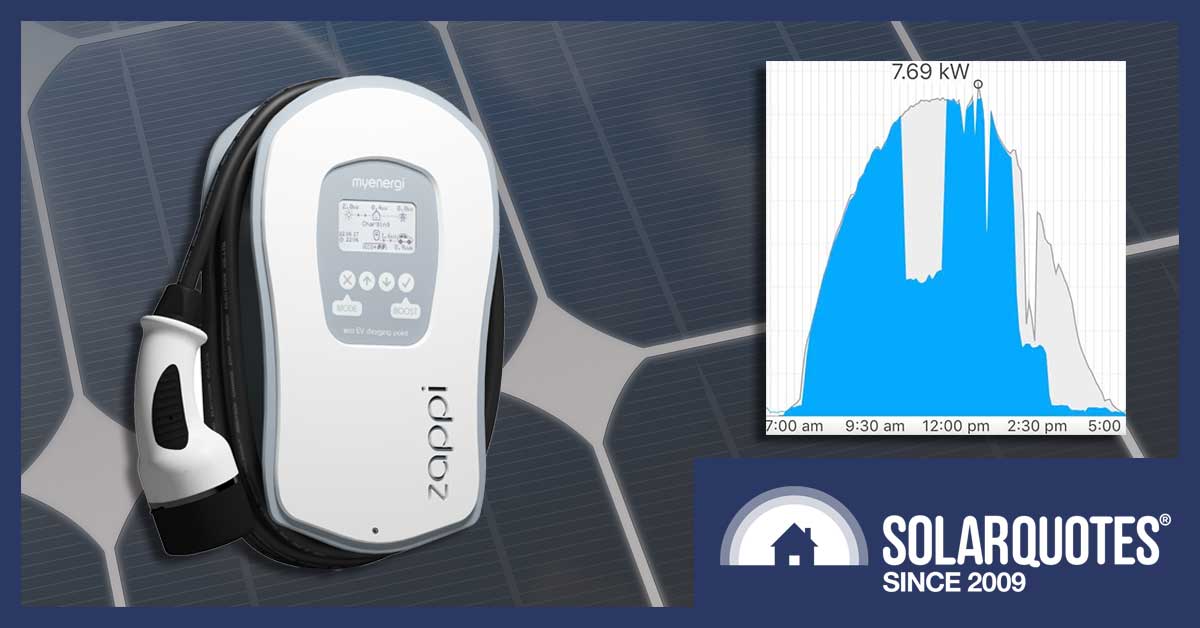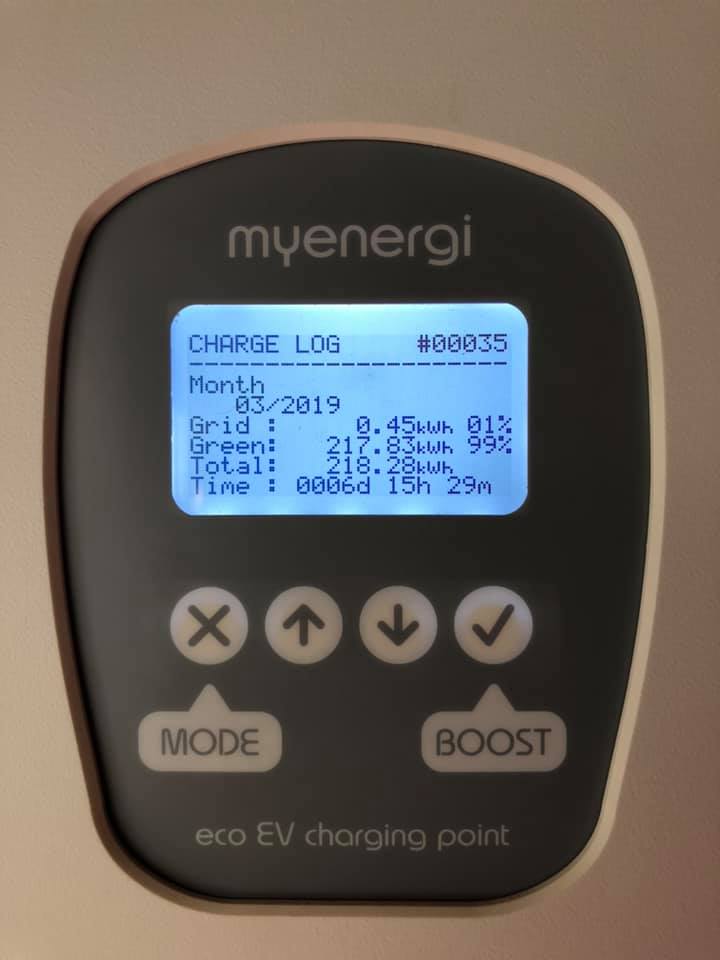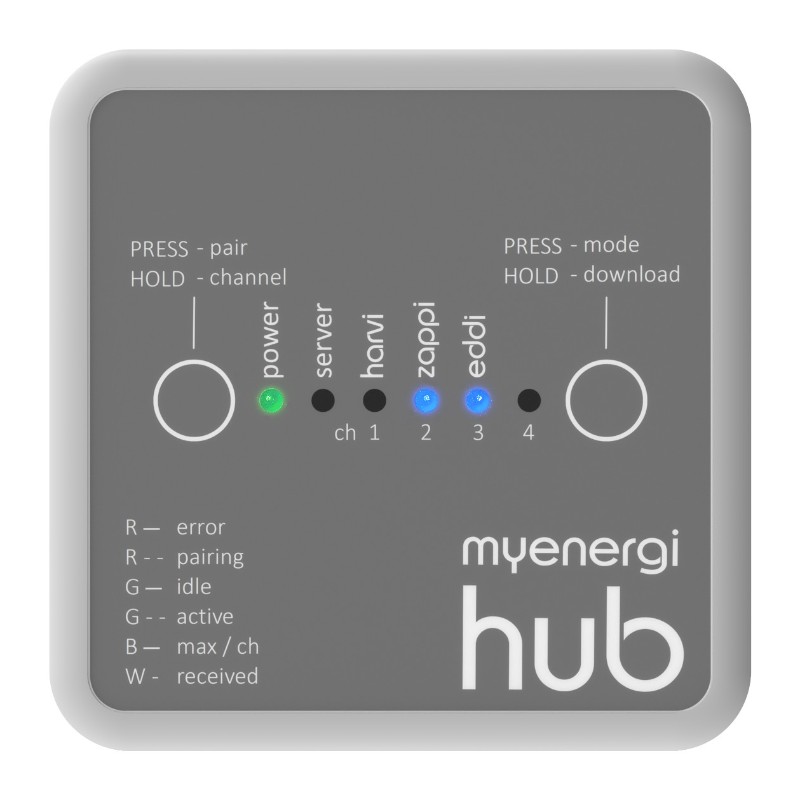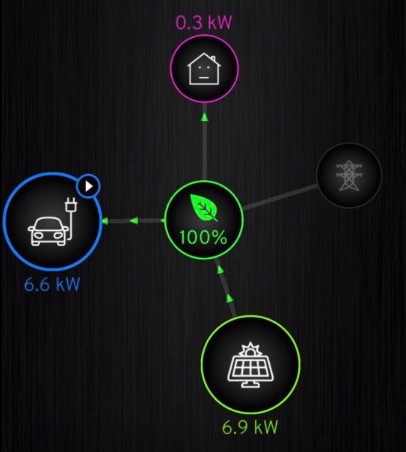
Chris from Queensland has owned a Zappi EV charger for over 3 months now. Find out what he thinks of it.
Readers will recall our previous discussions of solar diversion here and here, and my complaint that it’s too hard to do off-the-shelf.
One of the handful of fully off-the-shelf products we were alerted to is the Zappi charger, and last week I had the chance to discuss the product with a user in Queensland, Chris.
Having recently moved into a house and installed a hefty 10 kilowatts of solar power (connected to a single phase 8.2 kW Fronius inverter, export limited to 5 kW), charging for his BMW i3 was always going to be on the agenda.
“When we bought this house, the first thing we did was to put on the solar panels,” he told Solar Quotes. “There’s 10 kW on an 8.2kW inverter, with half facing north and half facing east”.
That let Chris watch the forums for a suitable EV charger with solar diversion, and that’s how the $1,100 Zappi electric car charger came to his attention.
At first, he told SolarQuotes, there wasn’t a local distributor, so he was looking at importing the charger from the UK, but during that process, Evolution Australia took on Australian distribution, and he had the Zappi installed by UV Power in Queensland.
Thanks to the hefty amount of power available (plus Queensland’s enviable weather),
“sometimes I’ve used less than 1% from the grid to charge the car and drive 1500km”, Chris told us.

That’s driving on 99% sunshine.
His Zappi is running off a single phase, limiting the charge current to 32A (7kW), but he said if you’ve got a three-phase system the charge power can be up to 22kW.
Not that Chris is suffering at the lower charge:
“Most of the time the car will be charging in the morning, so in summer it can be charged by 6 am Even now, it can be up to full charge by 10 am.”
He said the installer from UV Power knew electric car charging was on the cards before the Zappi was launched in Australia, so when the system was installed he had the charging circuit installed in the garage, which helped keep costs down when he found the Zappi.
The few hundred dollars for the installation also covered the CT sensing clamps, and Cat 5 cables for control communications (Chris decided to avoid using wireless to access the remote monitoring system).
So How Is The Zappi Performing In Practice?
Chris told us he’s surprisingly impressed at how closely and quickly the charger responds to conditions.
“I was shocked at how quickly it follows production – is there cloud? Does it need to slow down or stop? How does it respond to the pool pump, or the clothes dryer that fluctuates between 300W and 4kW? The Zappi follows those things without any issues”, he said. “It’s been rock solid.”
If PV output or the programmed surplus is lost, the Zappi will wait for a programmed time and see if the surplus has returned.
Charging the car from PV means taking advantage of Queensland’s export rules:
“I can’t export more than 5kW, so it has a control. I can maintain an export margin before charging, so for example there’s always 900W going out to the grid, and I minimise the wastage in my production”.
The only time Chris noticed it misbehaving, he said, was when he was trying to change the settings, and they wouldn’t update – but the “IT Crowd solution” (“Have you tried turning it off and turning it back on again?”) fixed it.
The other feature he singled out for praise is the Zappi’s tariff response:
“You can take advantage of cheap tariffs, and set up a smart boost” (which works backwards from the car’s charge state, to estimate timing to start charging at the “last second”).
You also program the Zappi to use only a certain percentage of the available power, he told us:
“You could start charging when you reach 50 percent availability, not pushing anything to the grid until it’s charged, and that’s customisable anywhere from 1 percent to 100 percent.”).
He’s also experimenting with the vendor’s latest offering, the Zappi Hub, which provides its connection to the Internet so he can monitor and control it remotely with an app.

The Zappi Hub connects the Zappi charger to the cloud.

The Zappi Hub’s app.
The Zappi Hub is “relatively new”, and Chris said he had to get it shipped from the UK.
“It’s buggy at this stage, but it definitely has potential”, he told us.
Added: You can compare specifications and estimated pricing of the Zappi with a bunch of other devices on SQ’s EV charger comparison page.

 RSS - Posts
RSS - Posts



This is great feedback, thank you. I’m installing a new rooftop solar system in September and I have already heard excellent reports on the Zappi. I intend buying an EV in around 2 – 3 years, and using a Zappi for solar charging the EV.
A question please – can a Zappi be retro-fitted to any inverter? I will likely install either a Solaredge or Fronius inverter. l probably won’t install the Zappi until I buy an EV in 2 – 3 years time – but, I want to ensure that the system I install will be compatible when I later attach a Zappi to the inverter. Plus, will this void the inverter warranty?
Also, how does a Zappi attach if a home battery is installed with a solar system? (I may or may not get a battery now).
Any advice is appreciated please.
The Zappi will work with any solar inverter, or for that matter wind or hydro. It monitors the feed to the grid, and if it is enough it will charge the battery rather than export to the grid.
Not sure about the battery, you can look at the Myenergi website in the UK
technically an EV is one of the few loads that can be modulatd.(by adjusting the PWM duty of the pilot signal).
other loads like heatpumps are less modulatable.
not sure if the zappi is using that feature to adapt to shading
Here’s another Queenslander using the Zappi with his Renault Zoe (more a story about the Zoe but interesting). Seems Qldrs are ahead of the curve.
https://thedriven.io/2018/10/15/how-this-renault-zoe-ev-drives-home-based-queensland-business/
It doesn’t care what your inverter is – it works off CT Clamps on your board sensing the net amount of solar energy available to charge. Technically it’s just another AC source on your distribution board, but it “knows” when there is excess solar energy available to use.
The good news is you can prioritise charging your car. If, for example, it’s a rainy day and you still need to charge the vehicle, it will charge from the grid instead, if you program it that way.
search “Fully Charged” and Zappi on YT for a hands on review.
I really like my myenergi products. My Zappi EV charger has been installed for 12 months now. I still haven’t used it as I am waiting for my Tesla Model 3. I have an Eddie hot water diverter to heat my two x 315L hot water systems during the day from my 31.08kW of solar panels (106 x 290/295watt REC Twin Peak II panels and 5x Fronius Primo inverters).
I have installed a Zappi also. Works fine. I also have a Solar Analytics monitor installed and can see how the Zappi follows the excess power that would otherwise be exported to the grid. This is in “Eco ++ ”
You can also choose fast mode which will charge at the maximum rate your EV will allow. My Leaf charges at a maximum rate of 3.8 kW.
The Zappi is connected like any other load to a separate 32A circuit breaker on your switchboard. The flow of power to or from the grid is measured by a Current Transformer (CT) around the grid connected active wire at the main breaker. The CT is connected by a thin signal wire to the Zappi. In the Eco ++ mode only when power is about to flow out to the grid will the Zappi activate and divert that power to the car.
I actually have a 3 phase connection to the grid and use a “Harvi” monitor to send signals to the Zappi. Slightly more complicated but works just fine.
Thanks for this info Arthur. I understand the use of CT clamps to determine amount of solar production being exported – but when a Zappi is connected, there must be a physical connection to divert the solar energy from the solar system to the Zappi EV charger. I don’t know if the Zappi must be hard-wired into the inverter, or into the wires transmitting solar production to the grid.
It sounds like you are saying the Zappi is connected to the switchboard, and not directly to the inverter – is this correct? Any further info is appreciated please.
Phil,
Lets take it in stages.
1. No solar, Zappi wired into your house switchboard.
In this configuration Zappi supplies AC power to your car just like any other appliance. (Just as it does on a cloudy and wet day when there is next to no solar power). You would use the fast mode for your Zappi
2. Add a solar system to your power sources.
The AC output from your solar inverter will power your household appliances and the Zappi. When you select Eco ++ mode on your Zappi it goes to the end of the solar power queue. The CT around your main supply active wire tells Zappi which direction power is flowing to or from the grid. In Eco++ mode only when power is flowing out to the grid will Zappi start to charge your car. When the sun goes behind a cloud or when you fire up too many other appliances and the flow is from the grid.
Zappi will pause supply to your car until the net power direction is again from your house to the grid and charging your car will resume.
While some other chargers may connect to your solar inverter Zappi is not one of those.
Zappi is more sophisticated than I have described in that charging rates can be set, time of day to charge, minimum rate of charge and many other nuances can be programmed.
https://myenergi.com/product/zappi/
https://evolutionaustralia.com.au/product-page/myenergi-zappi-7kw/
Arthur
Thanks Arthur for this helpful info.
I also found this video review of the Zappi very helpful https://www.youtube.com/watch?v=0EtegQfZQRw
Great explanation Arthur. So I take it, if you have a house battery, it will take whatever charge it needs and the Zappi in eco++ mode will only take what is exported to the grid from the inverter?. In other words the house battery comes first?
Hi Arthur, and anyone else reading this. a Harvi is NOT legal in Australia and despite some places having previously sold them (I don’t think they do any more) you should not be using them, unfortunately.
It uses 868mhz which is not legal to use in Australia, it is part of a Vodafone 4G allocation I think so they don’t allow anyone else to use it. I’d suggest they come under the same category as mobile repeaters, and massive fines can in theory be given out. (various sources have various figures, but can be up to $1mil apparently, though they are not likely that big for something like this)
https://myenergi.com/product/harvi/
https://iot.engineersaustralia.org.au/wiki-index/radio-frequency-rf-bands-r32/
I noticed this a while back and emailed the manufacturer directly, and got this response –
“Yes it is 868 mhz. https://www.evolutionaustralia.com.au/ Stock our products but they are told to disable the Ariel (sic) on the product.”
Evolution Australia should not be selling harvi’s, and should be disabling the antennas on Zappi’s and Eddi’s, otherwise they could be in a lot of trouble. Looks like they don’t sell it any more to me though.
I live off grid and have no capacity to export my excess power so charging an EV would be an ideal way of soaking up the 70% of energy I presently waste. I contacted myenergi and they told me Zappi only works with systems connected to the grid but an off grid (battery only) Zappi is something they may look at in the future.
Same here. I have an off grid, PV-Battery system (via Sol-Ark 12k). I was wondering about connecting to Zappi’s CT or some other sensor to the battery in lieu of a utility connection so that any excess power (after supplying a base load of refrigerators and LED lights) could be diverted entirely to 240V a/c line for an EV connection instead of to the batteries?
Zappi or others would be tapping into a significant market of people who have no access to the grid or prefer to stay away from it as much as practical.
The Zappi can be configured to work off grid but it will need a battery and a minimum of 1.4kw to trigger charging of your car.
Suggest you speak to EVolution regards this.
I’ve been following Fully Charged and the Zappi since its launch. Having recently enquired of Evolution they will have the 3 phase 22kW Zappi available soon.
I have installed a 3 phase charger 5 months ago Output is 22 Kw but remember your ev chooses the charge rate. My BYD will only accept 7kW – no better than single phase. The EQA Mercedes will accept 18kW and the zappi will provide this through 3 phases. A single phase charger will not allow you to scale up charging past 7kW when you buy your next car.
I have 20 Kw house battery as well and the Zappi does all sorts of magic tricks to ensure I only take power from the grid when I choose to.
Except when the clouds come over. The three phase version can only charge at higher rates. You have to manually trick it to charge when clouds come over. It’s pathetic and lacks the necessary automation.
The single phase won’t upset you so much
The Zappi will work with any inverter. There is clamp that goes over the cables and simply detects the amount of export. You could have multiple inverters and batteries and it would still be fine.
The question when combined with house battery is what do you want to charge first? I think you’ll need to decide that and get it wired appropriately. I would go car first personally but I could see scenarios where that wouldn’t be best.
I noted on a Fully Charged YT video on the Zappy it mentioned that some tweaking was necessary when installing the Zappi and a using a Powerwall 2 battery to ensure the Zappy operated correctly. As you have also alluded you ” need to get it wired appropriately” What exactly is required? Could you elaborate.
Thanks for this info Leslie. I understand the use of CT clamps to determine amount of solar production being exported – but when a Zappi is connected, there must be a physical connection to divert the solar energy from the solar system to the Zappi EV charger. I don’t know if the Zappi must be hard-wired into the inverter, or into the wires transmitting solar production to the grid. Any further info is appreciated please.
Phil,
You might also consider the Solaredge 7600H-US with integrated EV charger and their smart energy devices. These devices were designed to allow one to divert surplus solar energy to different types of loads.
Do any of the solar power diversion devices work with a refrigeration unit such as the one that makes ice in the Ice Bear 20?
Thanks for this Thomas. I recently learnt of the Solaredge solar EV charging inverter. I spoke to the Solaredge rep and he advised this is not yet available in Australia, but will be on sale here in around 6 weeks time. He also said that this inverter could not be linked to a home battery – so you must choose either rooftop solar and home battery (using a different inverter), or rooftop solar and EV charger.
To my way of thinking, an EV battery is far larger than a home battery. Plus, once bi-directional EV charging is available, this will allow me to use Vehicle 2 Home technology (V2H) to power the home at night using the solar energy stored in the EV battery. So why have both a home battery and an EV? It seems better economics to wait till EVs are cheaper and buy an EV in 2 – 3 years time and to use bi-directional charging (assuming it’s widely available, and can be retro-fitted to inverters etc).
(the new Nissan Leaf is bi-directional charging capable, and the required hardware is expected to be on sale in around a year. Other car makers are also developing this technology)
Great news ? I think? Basically I need to squeeze as long as possible out of my 15 year old 30kwh gel till all of these cool things are available. Good discussion. Thanks.
Been looking for a quicker charger, this looks like a great way to charge quickly, (in ASAP mode or whatever it’s called), or just use up the extra energy that I currently sell back for pennies. Thanks for the lead.
I live in QLD, with a 10kW array, 3 Phase and BMW i3. Zappi perfect for my requirements, but has an issue in ‘under reporting’ excess power available, eg the PV will typically be producing 9kW, and with house using 400W… the Zappi will report only 6kW avail. I’m no electrician, but note the PFs (Power Factors) on the 2 non-Zappi phases are typically around 0.5… and that if they were nearer the 3rd Phase value of 0.98 (where the Zappi is)… the numbers would stack up. Still awaiting clarification on all this from Zappi UK… as to why I’m getting this discrepancy in available power. Comments please?
I wonder the current clamps on two of the phases are transposed. To measure power the zappi would need to measure voltage somewhere too. A measued PF of 0.5 would make sense where the current is 120deg out of phase with the current.
It would also have the effect of showing the power direction on two of the phases being measured in the wrong direction, which during setup may get flagged. If so, the current sensors may also have been flipped.
@Simon Have you tried enabling Netphases? and which Zappi do you own? v1 or v2?
Looks like Chris has upgraded to the 3 phase v2 Zappi. That setup looks deeply impressive! https://youtu.be/cqNYWSAmJ5o
I have installed a Zappi 3 phase unit installed in preparation for my impending car arrival. I ordered the system based on its ability to direct excess solar production to my car before it goes to the grid. It is a smart solution and superior to the charger I could buy with my cars brand name on it.